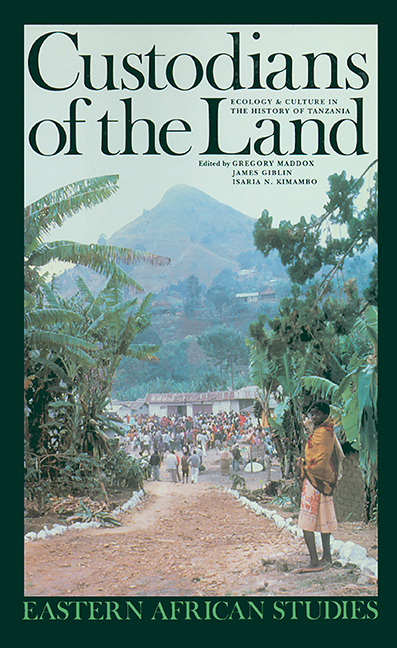Book contents
- Frontmatter
- Contents
- List of Maps, Figures & Tables
- List of Photographs
- Abbreviations
- Contributors
- Acknowledgements
- Introduction Custodians of the Land: Ecology & Culture in the History of Tanzania
- Part One Environmental & Demographic Change
- Part Two Environmental Change & Economic History: In Tanzania's Northern Highlands
- Part Three Politics & Environmental Change
- Part Four Environment & Morality
- Conclusion
- Bibliography
- Index
Part Two - Environmental Change & Economic History: In Tanzania's Northern Highlands
Published online by Cambridge University Press: 30 August 2017
- Frontmatter
- Contents
- List of Maps, Figures & Tables
- List of Photographs
- Abbreviations
- Contributors
- Acknowledgements
- Introduction Custodians of the Land: Ecology & Culture in the History of Tanzania
- Part One Environmental & Demographic Change
- Part Two Environmental Change & Economic History: In Tanzania's Northern Highlands
- Part Three Politics & Environmental Change
- Part Four Environment & Morality
- Conclusion
- Bibliography
- Index
Summary
The northern highlands of Tanzania have an extraordinarily interesting ecology and history. The snow-capped peaks and the volcanic soils which nourish prolific coffee plots and banana groves on Kilimanjaro are world-famous, of course, but even the less well-known Usambara Mountains boast uncommonly diverse communities of unusual flora and fauna. The human history of the highlands is no less intriguing than their natural history. Precolonial political and ideological creativity was so conspicuous in this region that Steven Feierman and Isaria Kimambo, writing in the 1960s about Usambara and the Pare Mountains respectively, were able to demonstrate that the richness and originality of indigenous political thought and institutions disproved diffusionist theories of African state-building.1 More recently, the research of Thomas Spear has shown that Mount Meru has also been the site of noteworthy historical development. As his contribution to *this volume tells us, the convergence of migrating farmers and pastoralists on Mount Meru produced a culturally diverse and agronomically sophisticated society. In the twentieth century, the farming communities of the highlands would become remarkably innovative. Even a government as strongly committed to preventing rural accumulation as the British colonial regime would have only very limited success in frustrating the efforts of mountain farmers to prosper through market production.
The chapters this section by Isaria Kimambo and Christopher Conte examine the relationship between environmental change and human history in the northern highlands. Kimambo presents a broad survey of precolonial developments in the Usambara and Pare Mountains and on Kilimanjaro. Thus he establishes the context in which Wambugu pastoralists, the subject of Conte's closely focused case study, settled in Usambara and transformed the forests of its high plateaux.
Isaria Kimambo's chapter is principally concerned with the sources of precolonial economic innovation. Hence it seeks to understand the precolonial precursors of the impulses towards improvement and entrepreneurship which are so prominent in Spear's discussion of Mount Meru during the colonial period. Although Kimambo considers that population increase and political structures may have stimulated agricultural intensification, the utilization of diverse microenvironments and the adoption of American cultigens, he is ultimately more interested in how trade provides incentives for innovation. Implicitly challenging views of the Tanzanian past which regard commerce as having been an alien innovation (see the Introduction to this volume), he argues that highland markets are old institutions where villagers acquired food and other goods which were necessary for survival.
- Type
- Chapter
- Information
- Custodians of the LandEcology and Culture in the History of Tanzania, pp. 67 - 70Publisher: Boydell & BrewerPrint publication year: 1996

